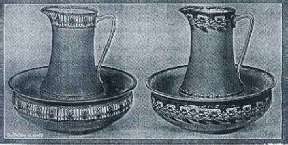
The Pottery Gazette and Glass Trade Review
March 1, 1923 Pages 425-427
John Steventon & Sons, Ltd, Royal Pottery. Market Place, Burslem (late Brown & Steventon), continue to bring out some very interesting lines in their popular priced domestic earthenware. When we last referred to the firm's operations they were in the early stages of initiating a type of decorative treatment that was more or less new to them, viz, a range of stenciled and shaded patterns. From what we saw of the firm's arrangements, we made bold to say that this style of decoration bade fair to become a strong feature in the future trade of this house Our prophecy has been amply fulfilled, as anyone who makes a point of visiting the firm's London showroom at 59 Shoe Lane, EC4 (in charge of Mr J.E.Holt) will at once be prepared to admit.
The fact that the demand that has been made upon the firm for this style of decoration has placed the management under the necessity of fitting out an extensive workshop for dealing with this class of ornament alone. The new series begun with a rose pattern, executed in a strong gay colouring which stood out forcefully upon a background of grey or drab. So popularly was this new style of decoration received that the firm has now felt it necessary to bring out numerous treatments of the same family. Consequently, in the way of floral decorations, the buyer has now the choice of rose, iris, sweet pea, pansy, viola or poppy; and a start has been made upon the fruits by the institution of a grape pattern, offered in equally good colouring.
The variation of the themes and the alternation of the types of colouring which are incidental there to have co-operated to strengthen very considerably the firm's range of decorative wares, particularly in the realm of toiletware and fancies. A similar type of handling has now been adopted in border styles instead of all overs, the said borders being applied to a self-coloured ground of pink, kingfisher blue, mauve, green , primrose, or celeste, all of which colours are strong and sound in their depth of body. This new and much more vigorous style of decoration has done much to invigorate the productions of John Steventon & Sons Ltd, in general..
As one enters the firm's showroom nowadays, one is astounded to notice the way in which strong colours has invaded a domain that was previously regarded as strictly popular, and, first and foremost, utilitarian. The firm has obviously been converted to the idea that their wares, because they are inexpensive, need not necessarily be dull or matter of fact. They seem to have laid themselves out to bring a strong measure of good colouring within the range of the popular classes, and if this has been their principal aim, they have certainly succeeded very well indeed. In the toiletware department, two fine new toilets have been brought out quite recently of another class. These both on the "Trent" shape are the Nos 327, 328.

As conventional patterns, these are really smart, and quite up to the present demand for the market. In the realm of fancies, a series of floating bowls, with the different coloured interior grounds, and border patterns outside, ought certainly to be seen by every dealer who has not yet encountered the line, for in some of these patterns the effect is as smart as anything that we have seen offered at a strictly competitive price..
In the suite ware, also, the firm has many powerful lines to offer, from plain prints, such as the well known "Bluebird Chintz" up to the styles which embody a strong note of colour. John Steventon & Sons Ltd, are specially strong on jugs, in which they have countless decorations in plain prints, illuminated prints, and lithos. In the production of teaware, the firm has made definite forward strides, and a point that we are pleased to call to the notice of everyone in the distributing quarters of the trade is that they now box the whole of their 21 piece sets, and thus offer them to the trade in a form that is bound to induce business.
Lastly, in dinnerware John Steventon & Sons, have many attractive lines, although in this last mentioned department they practically confine their operations to plain prints and lithos. They have two new decorations of the "Derby" type which give promise of being well received, and which ought to be seen by all who have a market for this style of decoration.
The progress that the house under notice has been made during the last six months in the matter of the enlivenment of its decorations is serving of special emphasis in these columns, and we can strongly recommend our readers to take steps to verify for themselves the impressions that we have endeavoured to put into print with all the fairness to the firm concerned and having regard to their strictly competitive standing in the trade. Their productions stand upon a plane where business is much sought after for just now, but they are good value and will withstand comparison.